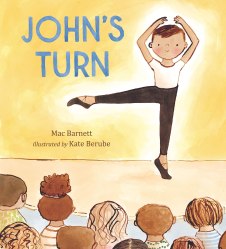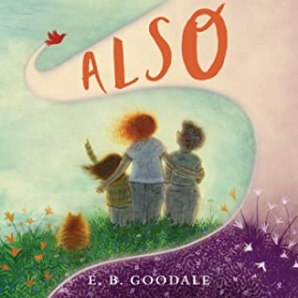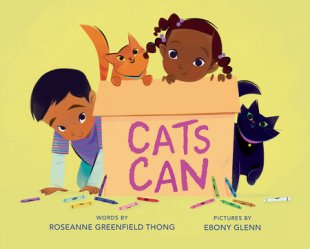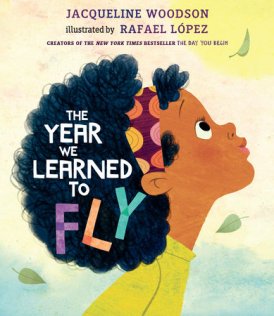I haven’t been keeping up with this blog so far this calendar year simply because I haven’t been keeping up with reading. Not to throw my daughter under the bus or anything, but I think it’s fair to blame her. I’m pleased to announce that she loves books and often insists upon reading as many as 16 bedtime books, but unfortunately for me, they tend to be more or less the same 16 books every time. And she has no preference for recently published books. But here are ten picture books from 2022 that I’ve managed to read over the last couple months.
 John’s Turn by Mac Barnett, illustrated by Kate Berube
John’s Turn by Mac Barnett, illustrated by Kate Berube
As a former ballet dancer, I’m always drawn to children’s books about ballet, especially ones that have received good reviews like this one. But I’m often disappointed by their inaccurate depictions. Sometimes, they make ballet sound too easy, or they describe a class without understanding that there’s a very specific structure to a ballet technique class. Picture books about ballet often get pointe shoes completely wrong, and chapter books about ballet often depict a beginner somehow already being really good. So when I come across a mainstream, star-reviewed book that depicts ballet accurately, I really appreciate it. This is one of those books. The plot is simple; a student named John performs a ballet piece at the end of Assembly at school one Friday. But the accurate depiction of John’s dance attire and choreography, as well as his stage fright, make this book well worth the read for young readers who, like me, want to read books that describe ballet accurately. Although the characters are school-aged and the font in this book is relatively small, it’s brief and simple enough to read aloud to preschool-aged children.
The Library Fish by Alyssa Satin Capucilli, illustrated by Gladys Jose
Mr. Hughes the librarian isn’t sure where Library Fish came from, but he knows she loves stories. She also loves greeting library visitors, watching them borrow and return books, and going on outings on the bookmobile. But one snowy day, the library stays closed. Not even Mr. Hughes comes to greet Library Fish. She has to figure out how to get to the story books herself. This light-hearted picture book is perfect for newly independent readers in the early-elementary age range, especially those who already love reading and can relate to Library Fish’s feelings about stories.The collage-style artwork includes little bits of text, as if it’s made from recycled book pages, which will give kids something interesting to notice if they choose to linger on each page for a while or to read the book multiple times.
 Bake Infinite Pie with X+Y by Eugenia Cheng, illustrated by Amber Ren
Bake Infinite Pie with X+Y by Eugenia Cheng, illustrated by Amber Ren
In this brilliant picture book, siblings X and Y learn a variety of mathematical concepts while baking pies with their Aunt Z. The picture book format and bright, simple illustrations make this book look easy-to-read, and the reading level is somewhere between first grade and third grade depending upon whether you’re looking at length, sentence structure, or vocabulary, but the mathematical concepts described include infinity, fractals, exponents, and even convergence to zero, which is essentially an introduction to calculus. Still, thanks to its narrative format with lots of dialogue, this book will have plenty of appeal for young readers, even those who think they hate math. The pie theme helps, too! At the very end, this book includes a recipe for banana butterscotch pie. Strongly recommended for mathematically-minded elementary-school-age kids or for homeschool families, especially those with students at a variety of ages.
Birds on Wishbone Street by Suzanne Del Rizzo
Moe’s close-knit neighborhood includes people of a variety of ethnic backgrounds, including a family that has just arrived from Syria. The new kid, Sami, is a little shy, but Moe bonds with him over a shared interest in birds. While the neighborhood kids are playing in the snow, they find a stunned cardinal. Working together but relying mostly on Sami’s knowledge of birds, they care for the hurt bird until it is ready to be released. The story is accompanied by a distinctive artistic style that uses polymer clay, which does a beautiful job of capturing the textures of clothing and feathers. The book includes a recipe for bird suet treats and instructions for building “winter roosting pockets.” I recommend this book for bird-lovers, especially those in the six-to-eight age range, and it may also appeal to readers who are specifically looking for books about making friends with new neighbors or about ethnic diversity.
 The Tide Pool Waits by Candance Fleming, illustrated by Amy Hevron
The Tide Pool Waits by Candance Fleming, illustrated by Amy Hevron
Despite its narrative structure and its relatively sparse text that’s printed in a nice big font, I would consider this a nonfiction picture book rather than fiction. It describes Pacific marine wildlife and the repetitive change of the tides by zooming in on a single tide pool. The title emphasizes the cyclical nature of the change of the tides because it comes from both the beginning and the end of the book. In fact, the title page is cleverly incorporated into the narrative. Three pages of back matter include further information about each of the marine creatures depicted in the book, a diagram depicting the different tidal zones, and a few webpages where readers can find videos and virtual simulations of tide pool exploration. I would recommend this book for a young independent reader with an interest in marine biology, or, if you skip the informational back matter, as part of an ocean- or beach-themed preschool storytime.
 Also by E.B. Goodale
Also by E.B. Goodale
Sometimes, a sentimental picture book has greater appeal for adult readers than for the children. But that’s not a bad thing; in fact, when I was a children’s librarian who regularly planned storytimes, I often liked to finish with a short book that I knew the parents would find sweet and touching. This is exactly that kind of book. It depicts a single moment in eight ways. Each of the four characters (child, mother, grandmother, and the cat) experiences the moment from a different perspective, but also, each of the four is reminded of a different moment from their own childhood. With minimal text, this simple story tells us how precious childhood memories are, especially memories that include the people we love, and reminds us that good memories allow us to be “here… and also there” at the same time.
This Is (Not) Enough by Anna Kang, illustrated by Christopher Weyant
This is the sixth book featuring the fuzzy bear-like characters from the creators’ Geisel-award-winning 2014 book You Are (Not) Small. This time around, the two main characters are each trying to find the perfect gift for the other, but nothing quite seems good enough. Every time they start to feel confident about their current gift ideas, they cross paths and each come away from the encounter feeling like they need a better, more special gift. The larger, yellowish character eventually builds a swing that he is excited to present to his friend, but the smaller purplish character still feels that the long, colorful scarf he knitted is not enough. But in the end, both friends love their gifts. The simple plot and controlled vocabulary make this a great book for newly independent readers at a kindergarten or first grade level.
 Cats Can by Roseanne Greenfield Thong, illustrated by Ebony Glenn
Cats Can by Roseanne Greenfield Thong, illustrated by Ebony Glenn
Perfect for reading aloud, either one-on-one or as part of a storytime, this rhyming picture book conveys a combination of affection and exasperation (but mostly affection) for the antics and mannerisms of cats. The bright, two-dimensional artwork features four characters, two human and two feline. Older readers may notice that much of the text describes the kids as well as the cats. The human children seem to be biracial Black/Asian siblings, although the text does not specify either their relationship or their race. The cheerful-looking fluffy orange tabby and green-eyed black cat will make this book a great choice for cat lovers, and the full-page illustrations have bright, solid-colored backgrounds that will appeal to even very young readers, as confirmed by my ten-month-old daughter.
The World Belonged to Us by Jacqueline Woodson, illustrated by Leo Espinosa
This nostalgic book about summertime in the city seems to be set in the ‘70s based on the characters’ clothing in the illustrations, although the text is more specific about the place than the time. It starts “In Brooklyn/ in the summer/ not so long ago” and goes on to describe the freedom of playing outside all day every day with virtually no adult supervision. The text is technically prose, but has a poetic tone that is underscored by the repetition of the introductory phrase and sometimes the use of font color changes instead of punctuation. Unfortunately, most of the target audience will be unable to relate to the kind of freedom depicted. This book could certainly be a good conversation-starter among adults about the importance of play and the limitations caused by adult intervention. But for children, this book lacks the “relatable” and “nostalgic” aspects that so many adult readers have praised it for in their online reviews.
 The Year We Learned to Fly by Jacqueline Woodson, illustrated by Rafael Lopez
The Year We Learned to Fly by Jacqueline Woodson, illustrated by Rafael Lopez
Woodson’s concise, lyrical text and Lopez’s vibrant, two-dimensional illustrations may seem simple and preschooler-friendly, but they pack an incredible amount of ideas, themes, and topics into a single picture book. The story depicts a brother and sister following their grandmother’s advice to overcome boredom, anger, loneliness, and fear through the power of their imaginations. It explores not only the common children’s-book themes of emotions and imagination, but also alludes to African American history, specifically slavery, and talks about adversity and resilience without using big words. Observant young readers will note that the narrator ends up internalizing her grandmother’s wisdom to the extent that the grandmother disappears from the story and the protagonist takes on her role in the narrative structure. For me personally, the flying motif was particularly interesting because I’ve taken enough courses in literature and folklore to know that flight is a common element in African American literature because it was used in slave folk stories both as a code to talk about literal escape and as a metaphor about “rising above” hardships. The author’s note at the end puts this concept into child-friendly language and credits the book The People Could Fly (written by Virginia Hamilton, illustrated by Leo and Dianne Dillon, originally published in 1985) as her inspiration.